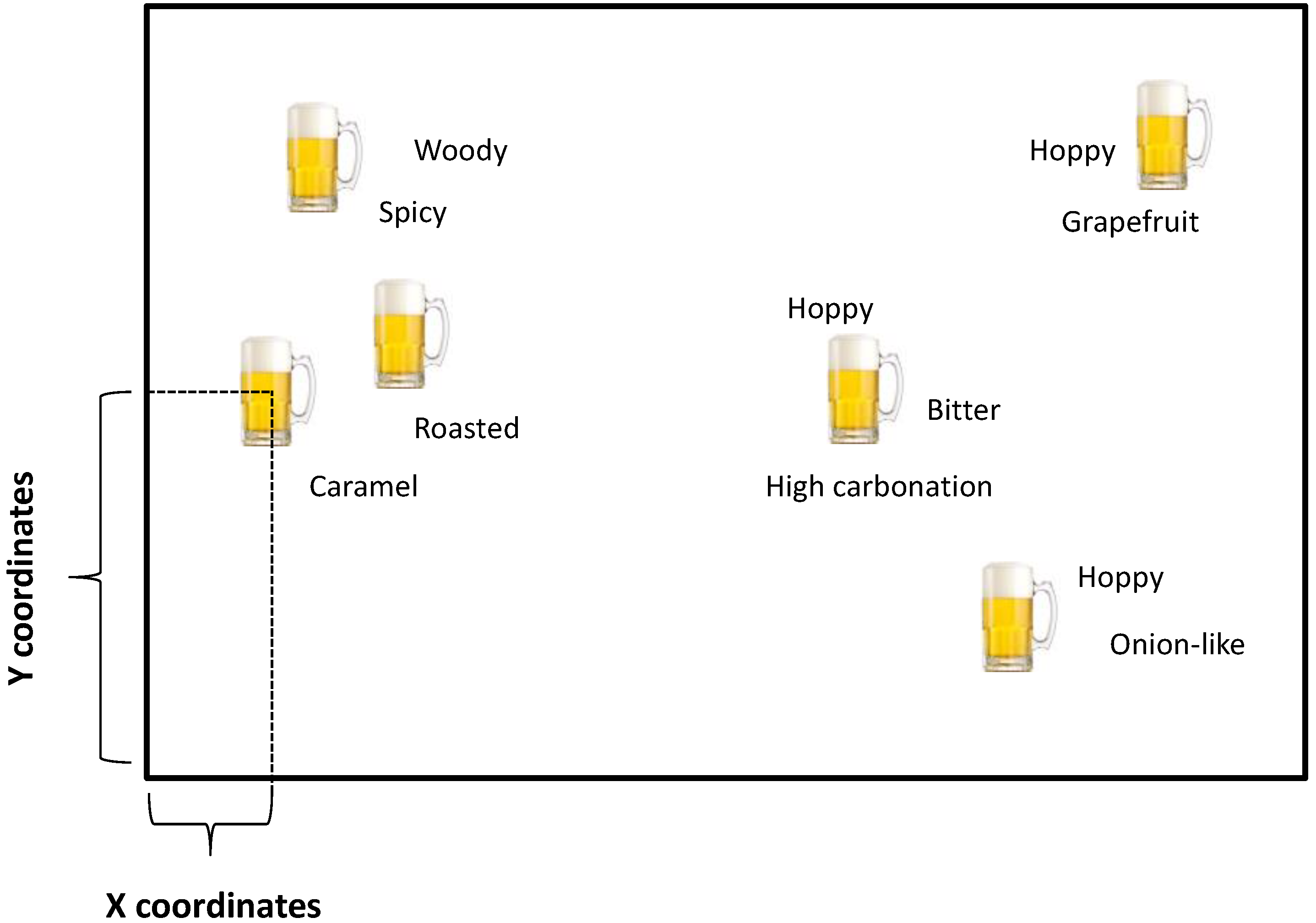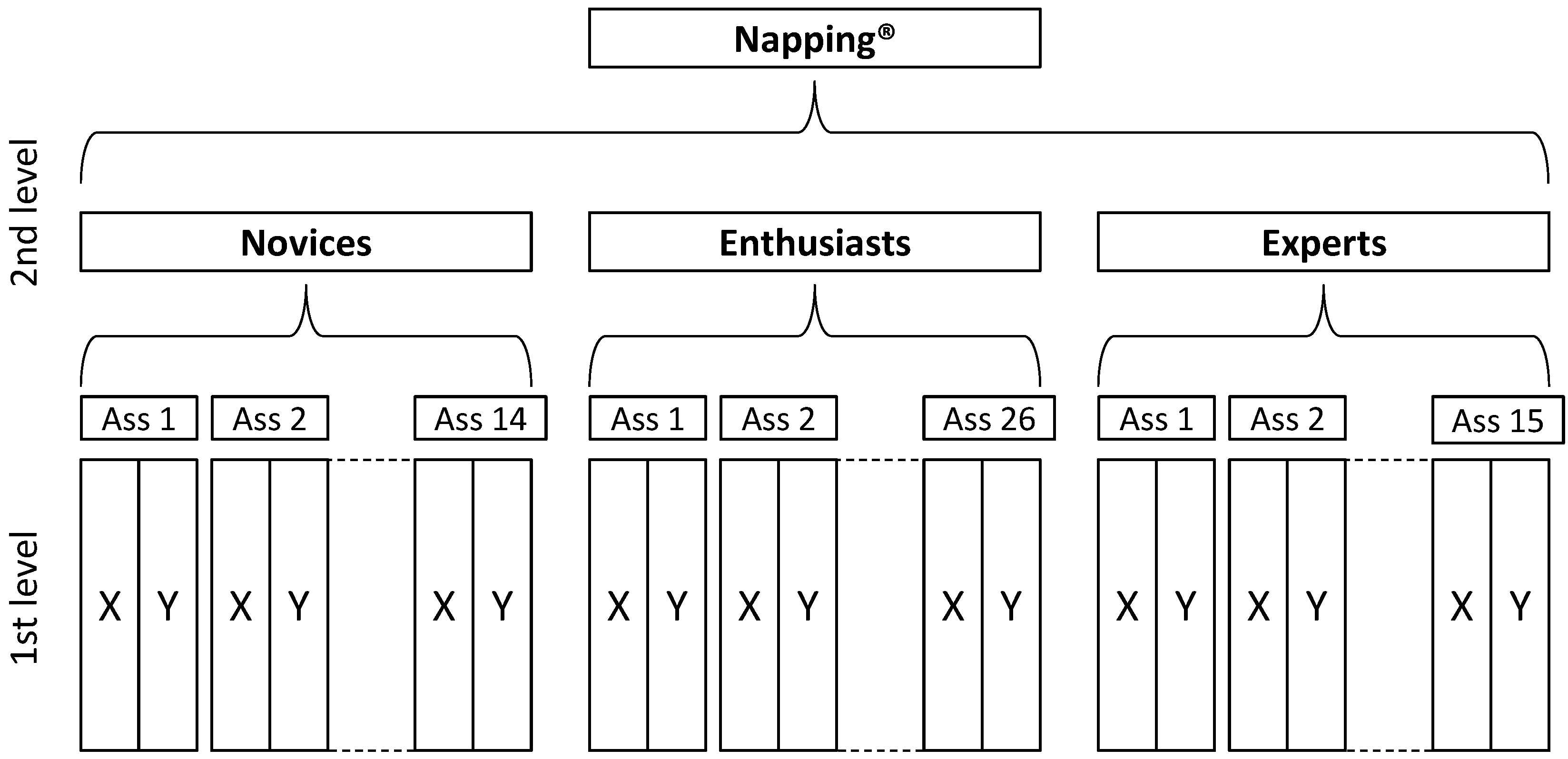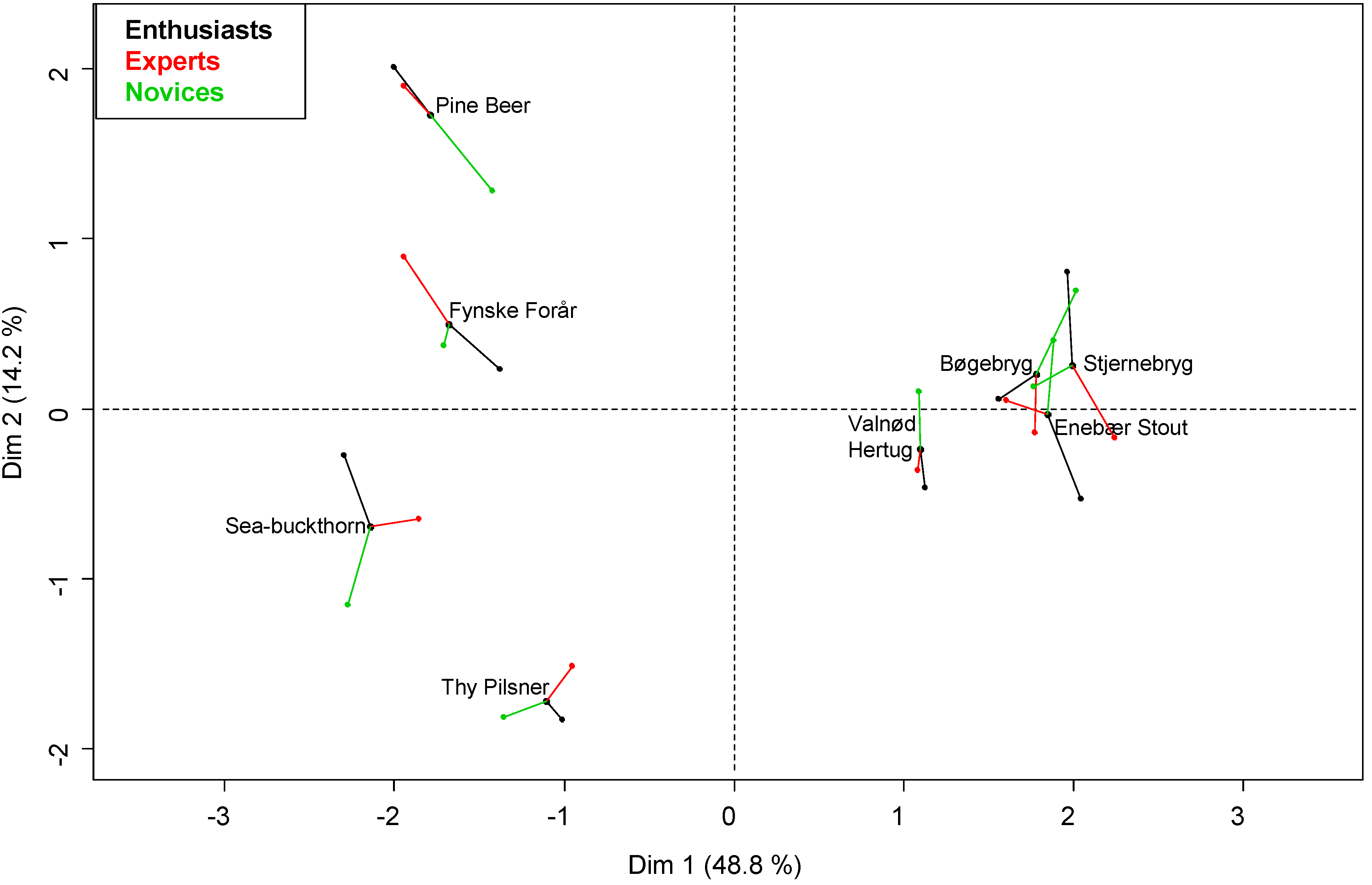Perception and Description of Premium Beers by Panels with Different Degrees of Product Expertise
Abstract
:1. Introduction
1.1. Sensory Profiling of Beer
1.2. Aims of the Present Study
2. Materials and Methods
2.1. Samples
2.2. Assessors
2.3. Experimental Procedures
2.4. Data Analysis
3. Results and Discussion
3.1. Configurational Congruence
3.2. Verbal Description
4. Conclusions
Acknowledgments
Author Contributions
Conflicts of Interest
References
- Hughes, P.S.; Baxter, E.D. Beer: Quality, Safety and Nutritional Aspects; The Royal Society of Chemistry: Cambridge, UK, 2001. [Google Scholar]
- Meilgaard, M.C. Predictions of flavour differences between beers from their chemical composition. J. Agric. Food Chem. 1982, 30, 1009–1017. [Google Scholar] [CrossRef]
- Liu, C.; Dong, J.; Wang, J.; Yin, X.; Li, Q. A comprehensive sensory evaluation of beers from the Chinese market. J. Inst. Brew. 2012, 118, 325–333. [Google Scholar] [CrossRef]
- Brown, D.G.W.; Clapperton, J.F. Discriminant analysis of sensory and instrumental data on beer. J. Inst. Brew. 1978, 84, 318–323. [Google Scholar] [CrossRef]
- Guyot-Declerck, C.; François, N.; Ritter, C.; Govaerts, B.; Collin, S. Influence of pH and ageing on beer organoleptic properties. A sensory analysis based on AEDA data. Food Qual. Preference 2005, 16, 157–162. [Google Scholar] [CrossRef]
- Pangborn, R.M.; Lewis, M.J.; Tanno, L.S. Sensory quantification of bitterness and flavor of beer during storage. J. Inst. Brew. 1977, 83, 244–250. [Google Scholar] [CrossRef]
- Daems, V.; Delvaux, F. Multivariate analysis of descriptive sensory data on 40 commercial beers. Food Qual. Preference 1997, 8, 373–380. [Google Scholar]
- Guinard, J.; Uotani, B.; Schlich, P. Internal and external mapping of preferences for commercial lager beers: Comparison of hedonic ratings by consumers blind versus with knowledge of brand and price. Food Qual. Preference 2001, 12, 243–255. [Google Scholar] [CrossRef]
- Clapperton, J.F.; Piggot, J.R. Differentiation of ale and lager flavor by principal component analysis of flavor characterization data. J. Inst. Brew. 1979, 85, 271–274. [Google Scholar] [CrossRef]
- Gains, N.; Thomson, D.M.H. Sensory profiling of canned lager beers using consumers in their own homes. Food Qual. Preference 1990, 2, 39–47. [Google Scholar] [CrossRef]
- Chollet, S.; Valentin, D.; Abdi, H. Do trained assessors generalize their knowledge to new stimuli? Food Qual. Preference 2005, 16, 13–23. [Google Scholar] [CrossRef]
- Murray, J.M.; Delahunty, C.M.; Baxter, I.A. Descriptive sensory analysis: Past, present and future. Food Res. Int. 2001, 34, 461–471. [Google Scholar] [CrossRef]
- Ares, G.; Deliza, R.; Barreiro, C.; Gimenez, A.; Gámbaro, A. Comparison of two sensory profiling techniques based on consumer perception. Food Qual. Preference 2010, 21, 417–426. [Google Scholar] [CrossRef]
- Pagès, J. Collection and analysis of perceived product inter-distances using multiple factor analysis: Application of 10 white wines from the Loire valley. Food Qual. Preference 2005, 16, 642–649. [Google Scholar] [CrossRef]
- Frøst, M.B.; Giacalone, D.; Rasmussen, K. Alternative methods of sensory testing: Working with chefs, culinary professionals and brew masters. In Rapid Sensory Profiling Techniques. Applications in New Product Development and Consumer Research; Delarue, J., Lawlor, B., Rogeaux, M., Eds.; Elsevier: Cambridge, UK, 2015; pp. 363–382. [Google Scholar]
- Giacalone, D.; Ribeiro, L.M.; Frøst, M.B. Consumer-Based Product Profiling: Application of Partial Napping® for Sensory Characterization of Specialty Beers by Novices and Experts. J. Food Prod. Mark. 2013, 19, 201–218. [Google Scholar] [CrossRef]
- Liu, J.; Grønbeck, M.S.; Di Monaco, R.; Giacalone, D.; Bredie, W.L.P. Performance of Flash Profile and Napping with and without training for describing small sensory differences in a model wine. Food Qual. Preference 2016, 48, 41–49. [Google Scholar] [CrossRef]
- Louw, L.; Malherbe, S.; Naes, T.; Lambrechts, M.; van Rensburg, P.; Nieuwoudt, H. Validation of two Napping® techniques as rapid sensory screening tools for high alcohol products. Food Qual. Preference 2013, 30, 192–201. [Google Scholar] [CrossRef]
- Louw, L.; Oelofse, S.; Naes, T.; Lambrechts, M.; van Rensburg, P.; Nieuwoudt, H. Optimisation of the partial napping approach for the successful capturing of mouthfeel differentiation between brandy products. Food Qual. Preference 2015, 41, 245–253. [Google Scholar] [CrossRef]
- Perrin, L.; Pagès, J. Construction of a product space from the ultra-flash profiling method: Application to 10 red wines from the Loire valley. J. Sens. Stud. 2009, 24, 372–395. [Google Scholar] [CrossRef]
- Perrin, L.; Symoneaux, R.; Maître, I.; Asselin, C.; Jourjon, F.; Pagès, J. Comparison of three sensory methods for use with the napping® procedure: Case of ten wines from Loire valley. Food Qual. Preference 2008, 19, 1–11. [Google Scholar] [CrossRef]
- Risvik, E.; McEwan, J.A.; Colwill, J.S.; Rogers, R.; Lyon, D.H. Projective mapping: A tool for sensory analysis and consumer research. Food Qual. Preference 1994, 5, 263–269. [Google Scholar] [CrossRef]
- Reinbach, H.C.; Giacalone, D.; Machado, L.M.; Bredie, W.L.P.; Frøst, M.B. Comparison of three sensory profiling methods based on consumer perception: CATA, CATA with intensity and Napping®. Food Qual. Preference 2014, 32, 160–166. [Google Scholar] [CrossRef]
- Lê, S.; Pagès, J. Hierarchical Multiple Factor Analysis: Application to the comparison o fsensory profiles. Food Qual. Preference 2003, 14, 397–403. [Google Scholar]
- Escoufier, B.; Pagès, J. Multiple Factor Analysis. Comput. Stat. Data Anal. 1990, 18, 121–140. [Google Scholar] [CrossRef]
- Josse, J.; Pagès, J.; Husson, F. Testing the significance of the RV coefficient. Comput. Stat. Data Anal. 2008, 53, 82–91. [Google Scholar] [CrossRef]
- Martens, H.; Martens, M. Multivariate Analysis of Quality: An Introduction; John Wiley & Sons: Chichester, UK, 2001. [Google Scholar]
- Rinnan, A.; Giacalone, D.; Frøst, M.B. Check-all-that-apply data analyzed by Partial Least Squares Regression. Food Qual. Preference 2015, 42, 146–153. [Google Scholar] [CrossRef]
- R Development Core Team. R: A Language and Environment for Statistical Computing; R Foundation for Statistical Computing: Vienna, Austria, 2015; Available online: https://www.R-project.org/ (accessed on 10 October 2015).
- Lê, S.; Josse, J.; Husson, F. FactoMineR: An R package for multivariate analysis. J. Stat. Softw. 2008, 25, 1–18. [Google Scholar] [CrossRef]
- Mevik, B.H.; Wehrens, R. The pls package: Principal component and partial least squares regression in R. J. Stat. Softw. 2007, 18, 1–23. [Google Scholar] [CrossRef]
- Lawless, H.T.; Glatter, S. Consistency of multidimensional scaling models derived from odor sorting. J. Sens. Stud. 1990, 5, 217–230. [Google Scholar] [CrossRef]
- Meilgaard, M.C.; Dalgliesh, C.E.; Clapperton, J.F. Beer flavor terminology. J. Inst. Brew. 1979, 85, 38–42. [Google Scholar] [CrossRef]
- Lawless, H.T. Flavor description of white wine by “expert” and nonexpert wine consumers. J. Food Sci. 1984, 49, 120–123. [Google Scholar] [CrossRef]
- Guerrero, L.; Gou, P.; Arnau, J. Descriptive analysis of toasted almonds: A comparison between expert and semi-trained assessors. J. Sens. Stud. 1997, 12, 39–54. [Google Scholar] [CrossRef]
- Urdapilleta, I.; Parr, W.; Dacremont, C.; Green, J. Semantic and perceptive organization of sauvignon blanc wine characteristics: Influence of expertise. Food Qual. Preference 2011, 22, 119–128. [Google Scholar] [CrossRef]



| RV | p | |
|---|---|---|
| Experts vs. Novices | 0.92 | 0.003 |
| Experts vs. Enthusiasts | 0.93 | 0.003 |
| Novices vs. Enthusiasts | 0.91 | 0.005 |
| Attribute | Novices | Enthusiasts | Experts | Total | χ2 (2) | p Value |
|---|---|---|---|---|---|---|
| Sweet | −2.2 | +2.9 | −0.6 | 127 | 4.2 | 0.123 |
| Bitter | −1.1 | +1.4 | −0.2 | 102 | 1.0 | 0.613 |
| Hoppy | −1.3 | +2.4 | −1.1 | 55 | 8.4 | 0.015 |
| Caramel | −1.6 | +1.4 | +0.2 | 49 | 0.2 | 0.678 |
| Sour | −1.0 | +1.0 | −0.1 | 47 | 1.8 | 0.410 |
| Light | +0.1 | +0.1 | −0.9 | 33 | 4.8 | 0.090 |
| Liquorice | −0.2 | +0.3 | −0.1 | 32 | 0.3 | 0.863 |
| Acidic | −0.8 | +0.6 | +0.2 | 29 | 4.7 | 0.093 |
| Spicy | +0.2 | +0.2 | −0.4 | 28 | 0.7 | 0.702 |
| Full | −0.4 | +0.6 | −0.3 | 26 | 0.5 | 0.781 |
| Malty | −1.0 | +1.0 | +0.1 | 26 | 6.8 | 0.033 |
| Elderflower | −0.1 | +0.8 | −0.6 | 25 | 3.5 | 0.174 |
| Fruity | −0.7 | +0.1 | +0.4 | 25 | 5.0 | 0.082 |
| Floral | −0.1 | +0.5 | −0.5 | 24 | 2.2 | 0.324 |
| Alcoholic | −0.6 | +0.3 | +0.3 | 21 | 4.2 | 0.124 |
| Citrus | −0.1 | +0.5 | −0.4 | 21 | 1.3 | 0.519 |
| Fresh | +0.1 | +0.5 | −0.7 | 21 | 4.1 | 0.126 |
| Piney | +0.3 | +0.7 | −1.0 | 20 | 5.4 | 0.068 |
| Yeasty | −0.3 | +0.4 | −0.1 | 20 | 0.5 | 0.760 |
| Pilsner | −0.5 | +0.5 | +0.1 | 19 | 0.3 | 0.867 |
| Neutral | −0.5 | +0.3 | +0.1 | 17 | 2.5 | 0.291 |
| Nutty | +0.1 | +0.4 | −0.5 | 17 | 4.8 | 0.090 |
| Strong | +0.1 | −0.1 | +0.1 | 17 | 2.3 | 0.319 |
| Smoky | +0.4 | −0.4 | −0.1 | 15 | 8.7 | 0.012 |
| Burnt | −0.5 | +0.6 | −0.1 | 14 | 5.5 | 0.041 |
| Thin | +0.2 | +0.1 | −0.3 | 14 | 2.7 | 0.263 |
| Dry | −0.5 | +0.4 | +0.1 | 13 | 4.6 | 0.100 |
| Grainy | −0.4 | +0.6 | −0.2 | 13 | 2.6 | 0.273 |
| Summer | +0.3 | +0.1 | −0.4 | 13 | 6.3 | 0.042 |
| Watery | −0.4 | +0.6 | −0.1 | 13 | 3.1 | 0.211 |
| Coffee | −0.4 | +0.5 | −0.1 | 12 | 4.3 | 0.118 |
| Ester | −0.5 | −0.5 | +1.0 | 12 | 25.2 | <0.001 |
| Roasted | −0.2 | +0.4 | −0.3 | 12 | 1.8 | 0.393 |
| Soapy | −0.1 | +0.4 | −0.3 | 12 | 1.8 | 0.393 |
| Woody | +0.5 | −0.1 | −0.3 | 12 | 11.1 | 0.003 |
| Apple | −0.3 | +0.1 | +0.2 | 11 | 3.4 | 0.181 |
| Walnut | −0.2 | +0.4 | −0.2 | 11 | 1.2 | 0.544 |
| Anise | −0.2 | +0.4 | −0.2 | 10 | 2.3 | 0.320 |
| Chemical | −0.2 | −0.3 | +0.4 | 9 | 11.8 | 0.003 |
| Chocolate | −0.2 | +0.5 | −0.3 | 9 | 3.4 | 0.180 |
| Christmas | −0.1 | −0.1 | +0.1 | 9 | 1.4 | 0.494 |
| Old | −0.4 | −0.2 | +0.6 | 9 | 14.6 | <0.001 |
| Round | −0.2 | +0.2 | −0.1 | 9 | 0.2 | 0.879 |
| Berries | +0.2 | −0.1 | −0.2 | 8 | 5.9 | 0.052 |
| Banana | −0.3 | +0.3 | −0.1 | 7 | 2.7 | 0.260 |
| Heavy | +0.4 | −0.1 | −0.3 | 7 | 13.7 | 0.002 |
| Herbal | +0.4 | −0.3 | −0.1 | 7 | 9.2 | 0.005 |
| Honey | +0.1 | +0.2 | −0.3 | 7 | 2.9 | 0.230 |
| Regular | +0.1 | +0.1 | −0.1 | 7 | 3.7 | 0.151 |
| Spring | +0.1 | +0.2 | −0.3 | 7 | 2.9 | 0.230 |
| Sulfuric | −0.3 | −0.1 | +0.5 | 7 | 12.3 | 0.003 |
| Autumn | +0.2 | +0.1 | −0.2 | 6 | 6.0 | 0.050 |
| Low bitterness | −0.2 | +0.2 | +0.1 | 6 | 2.7 | 0.260 |
| Medicine | −0.2 | +0.3 | −0.1 | 6 | 3.5 | 0.176 |
| Perfume | +0.1 | −0.1 | −0.1 | 6 | 0.5 | 0.786 |
| Weak | −0.1 | +0.1 | −0.1 | 6 | 0.4 | 0.815 |
| Winter | +0.2 | +0.1 | −0.3 | 6 | 3.1 | 0.140 |
© 2016 by the authors; licensee MDPI, Basel, Switzerland. This article is an open access article distributed under the terms and conditions of the Creative Commons by Attribution (CC-BY) license (http://creativecommons.org/licenses/by/4.0/).
Share and Cite
Giacalone, D.; Ribeiro, L.M.; Frøst, M.B. Perception and Description of Premium Beers by Panels with Different Degrees of Product Expertise. Beverages 2016, 2, 5. https://0-doi-org.brum.beds.ac.uk/10.3390/beverages2010005
Giacalone D, Ribeiro LM, Frøst MB. Perception and Description of Premium Beers by Panels with Different Degrees of Product Expertise. Beverages. 2016; 2(1):5. https://0-doi-org.brum.beds.ac.uk/10.3390/beverages2010005
Chicago/Turabian StyleGiacalone, Davide, Letícia Machado Ribeiro, and Michael Bom Frøst. 2016. "Perception and Description of Premium Beers by Panels with Different Degrees of Product Expertise" Beverages 2, no. 1: 5. https://0-doi-org.brum.beds.ac.uk/10.3390/beverages2010005







